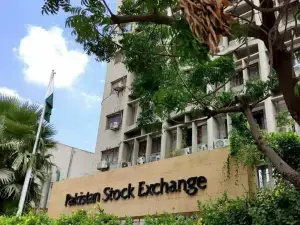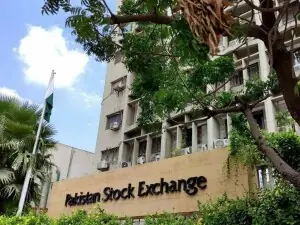The newly-appointed SBP Governor, Dr Shamshad Akhtar, while presiding over a mid-term review meeting of the National Credit Consultative Council (NCCC) on 23rd January expressed concern over ballooning banking spread and emphasised the need for passing on some benefits to the depositors in the wake of rising lending rates.
The gap between lending rates of every type of loans and return/interest rates on every type of deposits has been widening since the last about five years. Sometimes, the gap had been as wide as 8% to 10%. At the end of March 2005 as compared to June 2004, the spread increased to 5.86 percentage points from 5.28 percentage points showing an increase of 58 basis points.
If we scan the data released by SBP at the end of March 2005, we reach the conclusion that the weighted average lending rates of all banks increased to 7.29 percent from 6.49 percent, registering an incase of 80 basis points.
On the other hand, the weighted average rate paid to the depositors increased to 1.43 percent only from 1.21 percent showing an increase of 22 basis points. Thus the percentage increase in the lending rate was nearly 12.33% whereas the percentage increase in deposit rate was only 18.2% but this increase conceals the fact that the increase was scored on very low base.
If we compare the inflation rate of 10.25% in March 2005 with the return on deposits (as explained above) the result is mind-boggling. Nowhere in the world, the spread of banks increases by such a massive percentage which proves that the banks are very clever in keeping the increase in the lending rates faster than the increase in the return to the depositors.
It further proves the point that the Banks are not capable of lowering their administrative cost and sharing the benefits of higher income with the depositors.
Public at large and the business class in particular had been very forcefully asking to narrow down the difference between lending and deposit rates but the banks are not ready to change their way of doing business. The silence and non-intervention of the regulatory authorities, especially the State Bank, is all the more intriguing.
During the tenure of the immediate former Governor, it has been rightly observed by many experts that he unnecessarily gave a free hand to the banks to do whatever was in their interest to the detriment of depositors/clients of banks. Banks arbitrarily increased the threshold limits of deposits, especially in Savings Accounts, in some cases as high as Rs 50,000/-, or even more.
If these limits were breached by the depositors they were penalised in the shape of service charges on their deposits on monthly basis ranging from Rs 100 to Rs 1,000. It is an open secret that credit card users are being charged a minimum of 2% and a maximum of 3% per month on their over due balances whereas personal loans under the Credit Card scheme are being charged from 24% to 36% p.a. Have the Regulatory Authorities ever cared to intervene and protect the interest of the credit card users.
SBP owes an answer to the public in general and depositors in particulars as to why so much freedom has been given to the banks to plunder and loot the innocent depositors and other stakeholders. Under the Banking Companies Ordinance 1962 (Section 41), SBP is empowered to protect the interests of the public which does include the depositors.
On the implementation side, our central bank (the SBP) seems to have failed miserably in its duty of protecting the interest of the public in general and of depositors in particular. Inadequate returns to the depositors and ballooning profit of banks which is proved beyond doubt by the statistics and data issued by banks has not attracted the attention of the regulatory authority who are the guardians of public money.
It should be noted that return to depositors will not rise with the same speed as the banks lending rates unless the government increases the rates of return on NSS. Inadequate and poor returns on bank deposits has forced the depositors to invest their funds in the share market and this is proved by the fact that KSE 100 index recently has crossed yet another psychological barrier of 11,000 points.
Depositors have also invested massively in real estate sector whose prices have increased beyond imagination and economic reasoning. Experts and analysts have opined that the soaring profitability of banks by around 105% in nine months from January to September 2005 is not going to reduce or decrease in the year 2006.
Thus the fate of depositors will aggravate because Banks (as their past record shows) will not share the increasing profitability with the depositors unless SBP intervenes.
If we look at the financial highlights published in the newspapers in the year 2004 and 2005 of some the banks, we can easily conclude that from financial point of view, their performance is par excellence. But one aspect which is conspicuous by its absence is the data on return on profit paid to the deposit holders. Why the banks withhold this information.
The answer is because this is their grey area. They do not want to show the rate of return or profit paid on deposits because their record in this segment is very poor.
In the following paragraph, financial data are given on profits before tax, profits after tax, earning per share before tax, earning per share after tax of some banks whereas data on deposits, advances, investments, equity have been ignored to keep focus on the subject. Names of the banks are not being given because giving names is rather irrelevant. It would be observed that nowhere the growth rate is negative.
CY 2002 & 2003
==================================================================
(Rs in 000)
1. 2002 2003 Variance
------------------------------------------------------------------
1.1 Net Profit 319.000 630.000 97%
1.2 Earning per share (Before Tax) 6.86 7.70 12%
1.3 Earning per share (After Tax) 4.30 5.80 35%
------------------------------------------------------------------
2.
------------------------------------------------------------------
2.1 Net Profit (Before Tax) 6,045 9,009 49%
2.2 After Tax Profit 2,253 4,198 86%
2.3 E.P.S. 5.49 10.23 86%
------------------------------------------------------------------
2003-2004
1. (Rs in 000)
2003 2004 Variance
------------------------------------------------------------------
1.1 Profit (Before Tax) 81 359 344%
1.2 Profit After Tax 51 374 633%
1.3 E.P.S. (After Tax) 0.44 3.24 636%
------------------------------------------------------------------
2.
------------------------------------------------------------------
2.1 Net Profit (Before Tax) 165,000 276,000 67%
2.2 Net Profit (After Tax) 108,000 202,000 87%
2.3 E.P.S (Before Tax) 6.16 7.91 28%
2.4 E.P.S (After Tax) 4.04 5.80 44%
------------------------------------------------------------------
2004-2005
1. (Rs in million)
2004 2005 Variance
------------------------------------------------------------------
1.1 Profit Before Tax 541 1,258 133%
1.2 Profit After Tax 399 901 126%
1.3 E.P.S. 1.37 3.90 126%
------------------------------------------------------------------
2.
------------------------------------------------------------------
2.1 Profit Before Tax 189 647 242%
2.2 Profit After Tax 123 397 223%
2.3 E.P.S. 0.54 1.75 224%
============================================================
A cursory look at the above data/information from CYs 2002 & 2003 to CYs 2004 & 2005 reveals that in the area of profitability (before and after tax) and earning per share (before and after tax), banks have achieved tremendous growth rate of as high as 343%, 633% and 636% and very few banks achieved lower growth rate in this segment.
On the other hand, the highest deposit growth rate was 69% (CY2005 over CY2004) and lowest was 17%. A valid question now arises as to why in the area of profitability and earning per share, banks have achieved such great heights and why their performance in the area of deposit growth was not as good as in the area of profitability and earning per share.
The answer to this question is that the benefit of increase in lending rates is not being passed on to the depositors and increase in earning per share shows tremendous enrichment of shareholders at the cost of depositors which is very bad banking and corporate practice. In banking business, the debt/equity ratio is very high, sometimes as high as 80:20 and majority providers of funds are depositors who are not being treated honestly by the banks.
In other words, minority stakeholders (shareholders) are being pampered at the cost of majority stakeholders (depositors). Further, lower deposit growth rate as compared to profitability and earning per share proves that funds are being diverted by the deposit holders from banks to other investments opportunities like shares and real estate etc.
Whatever funds are being retained in the banking system by the deposit holders are due to safety/security considerations and not for earning any return. Banks should realise that depositors are not their captive customers.
A closer look at rates offered by various banks, including the public sector banks, shows that they pay some times nothing or zero percent to saving accounts if the amount is below certain limit arbitrarily fixed by them (say Rs 20,000, Rs 25,000, Rs 30,000 and as high as Rs 50,000), the lowest rate may be 0.20% (means 1/5th of 1%) and the highest rate may be between 1.5% to 2.5% with restrictions on amount to be kept in the Account (Say Rs 50,000, Rs 100,000 and sometimes as highs as Rs 150,000).
In the case of term deposits ranging from 6 months to 36 months, the scenario is not very different and least encouraging. For six-month deposits, one can get the highest return of 6% and the lowest of 1.80%. Highest deposit rates on one year, two years, three years tenures can be 7.25%, 7.50% and 8.25% and for getting maximum return on different tenure deposits there are upper benchmarking of amounts as well.
On the other hand, lending rates of banks are extremely high when compared to deposit rates. Newspapers generally in Pakistan publish KIBOR (Karachi Inter Bank Offered Rate) which is benchmark for pricing loans to the customers by the Banks. Different tenure rates from one week to three years are given in KIBOR.
While quoting rates to the customers, banks add their own margin (technically called 'Spread') on KIBOR which may be 5% or even more subject to a floor or minimum rate. For example, for one year tenure or two years tenure or three years tenure loans, one would have to pay 14.09%, 14.41% and 14.67%, respectively, with a floor rate ranging from 15% to 18%.
If we scan the financial indicators of banks, we can easily arrive at the conclusion that majority of the loans given by banks to their customers are financed by the depositors funds.
Thus, if we compare the rate of return given to depositors for different tenures and the rate of return on loans extended by banks to their customers, the difference between the two rates ranges between 7% and 10% - a very high spread by any standards. That surely proves that banks and their share holders are enriching themselves at the cost of hapless depositors.
SBP must intervene to stem the situation under powers vested in it vide section 41 of the Banking Company's Ordinance 1962 and better the lot of the depositors. It should advise the Government to increase the rate of return on NSS and force the bank to increase the return to depositors at least one or two percent above the inflation rate declared by the Government.
Alternatively, the return paid to the depositors should be linked with the weighted average rate paid on short term Treasury Bills auctioned by SBP on behalf of the Government with upper adjustment for longer duration deposits.






















Comments
Comments are closed.